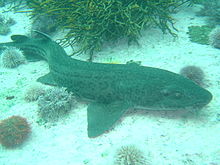Our website is made possible by displaying online advertisements to our visitors.
Please consider supporting us by disabling your ad blocker.
Leopard catshark
| Leopard catshark | |
|---|---|

| |
| Leopard catshark photographed at a reef at False Bay in Cape Town, South Africa | |
| Scientific classification | |
| Domain: | Eukaryota |
| Kingdom: | Animalia |
| Phylum: | Chordata |
| Class: | Chondrichthyes |
| Subclass: | Elasmobranchii |
| Order: | Carcharhiniformes |
| Family: | Scyliorhinidae |
| Genus: | Poroderma |
| Species: | P. pantherinum
|
| Binomial name | |
| Poroderma pantherinum (J. P. Müller & Henle, 1838)
| |

| |
| Range of the leopard catshark | |
| Synonyms | |
|
Poroderma marleyi Fowler, 1934
* ambiguous synonym | |
The leopard catshark (Poroderma pantherinum) is a species of catshark, and part of the family Scyliorhinidae, endemic to the coastal waters of South Africa. Abundant in inshore waters under 20 m (66 ft) deep, this bottom-dweller favors rocky reefs, kelp beds, and sandy flats. Growing to a length of 84 cm (33 in), the leopard catshark has a stout body with two dorsal fins placed well back, and a short head and tail. It is extremely variable in color and pattern, with individuals ranging from almost white to black and covered by diverse patterns of black spots, blotches, rosettes, and/or lines. The color pattern changes with age and some forms seem to be location-specific, suggesting the presence of multiple distinct, local populations. In the past, some of the more distinct color forms have been described as different species.
Mainly nocturnal in habits, after dusk the leopard catshark hunts for small, benthic bony fishes and invertebrates in shallow water. In daytime, it generally rests inside caves and crevices, sometimes in groups. This species has been documented ambushing spawning chokka squid (Loligo vulgaris reynaudi) within their spawning grounds. Reproduction is oviparous and proceeds year-round. Females produce rectangular, light-colored egg capsules two at a time, attaching them to structures on the sea floor. Small and harmless, the leopard catshark adapts well to captivity and is often exhibited in public aquariums. It is caught by commercial and recreational fishers as bycatch, and often killed as a pest. The International Union for Conservation of Nature (IUCN) has listed this species as least concern; its numbers do not seem to be declining, but heavy human activity occurs within its native waters. The possibly fragmented nature of its distribution also merits caution for each local population.
- ^ Pollom, R.; Gledhill, K.; Da Silva, C.; McCord, M.E.; Winker, H. (2020). "Poroderma pantherinum". IUCN Red List of Threatened Species. 2020: e.T161515A124498131. doi:10.2305/IUCN.UK.2020-2.RLTS.T161515A124498131.en. Retrieved 19 November 2021.
Previous Page Next Page



